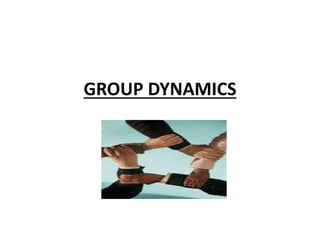
GROUP DYNAMICS.pptx
- 2. • The word “dynamics” comes from the Greek word meaning “force” hence group dynamics refers to the study of forces operating within a group. • Group Dynamics are viewed from the perspective of the internal nature of groups, how they from, their structure & processes, & how they function & affect individual members, other groups, & the organization.
- 3. Concept of Group- A group may be defined as the aggregation of small number of persons who work for common goals, develop a shared attitude, & are aware that they are part of a group & perceive themselves as such.
- 4. • A group can be defined as collection of two or more people who meet regularly and influence one another over a period of time, perceive themselves as a distinct entity distinguishable from others, share common values and strive for common objectives.
- 5. Features of Group • Two or more persons • Social interaction • stability • Collective identity • Shared Goal Interest • Recognition as being a group
- 6. Types of Groups • Primary & secondary Groups • Membership & Reference Group • Command & task Group • Formal & Informal Groups
- 9. Difference between formal and informal Basis Of Comparison Formal Group Informal Group Formation Planned & deliberate Spontaneous Purpose Well-set goals Social interaction Structure Well structured Unstructured Nature Official Unofficial Focus Positions Persons Leadership Superior Any one Source Of Power Delegated Given by Group Guidelines for Behavior Rules & procedures Group Norms, beliefs & Values
- 10. GROUP DEVELOPMENT Stages of Group Development
- 11. Contributions of Formal Groups Contributions to Organisations 1. Accomplish complex, independent tasks that are beyond the capabilities of individuals. 2. Create new ideas 3. Coordinate interdepartmental efforts. 4. Solve complex problems requiring varied information and perspectives. 5. Implement action plans. 6. Socialise and train newcomers. Contributions to Individuals 1. Satisfy needs for affiliation. 2. Confirm identity and enhance self-esteem. 3. Test and share perceptions of social reality. 4. Reduce feelings of insecurity and powerlessness. 5. Provide a mechanism for solving personal and interpersonal problems.
- 12. Contributions of Informal Groups Contributions to Individuals 1. Satisfaction of social and affiliation needs. 2. Satisfaction of needs for security and support. 3. Enhanced status for members if the group is perceived by others as prestigious. 4. Enhanced feelings of self-esteem if a member is valued by other group members. 5. Feeling more competent by sharing the power of the group to influence and achieve. Contributions to Organisations 1. Solidify common social values and expectations congruent with organisational culture. 2. Provide and enforce guidelines for appropriate behaviour. 3. Provide social satisfaction unlikely for anonymous individual workers to experience. 4. Provide a sense of identity that often includes a certain degree of status. 5. Enhance members’ access to information. 6. Help integrate new employees into the formal expectations of the organization.
- 13. Stages of Group Development
- 14. Group Decision Making Techniques for improving group decision making: • BRAINSTORMING • ELECTRONIC BRAINSTORMING • NOMINAL GROUP TECHNIQUE • DELPHI DECISION MAKING • DIALECTIC DECISION MAKING
- 15. BRAINSTORMING It is build around four basic guidelines for participants: • Generate as many ideas as possible • Be creative & imaginative • Extend or combine earlier ideas • Withhold criticism of other’s ideas.
- 16. There are two main principles that underline brainstorming: • DEFERRED JUDGEMENT • QUANTITY BREEDS QUALITY
- 17. ELECTRONIC BRAINSTORMING • Group members sit at personal computer terminals. • members feel they have more opportunity for participation & more flexibility, since they do not necessarily need to “meet” at the same time.
- 18. Nominal Group Technique- The process in Nominal Group Technique goes as follows: • The group leader outlines the problem requiring decision. • Each member writes down his ideas silently & independently presents his best single idea on the problem. • When all members write their ideas, these are presented for discussion & evaluation before the group members. • The members are asked to rank various ideas for decision making & the decision is arrived at on the basis of this ranking. • If the group does not reach agreement, it repeats the ranking & voting procedure until the group reaches some agreement & makes a decision .
- 19. Delphi Decision Making- • In Delphi decision groups, a panel of relevant people is chosen to address an issue. • Members are selected because they are experts or have relevant information to share & the time available to do so.
- 21. TEAM • A team is a group whose members influence one another towards the accomplishment of specified objectives. • A team is a small number of people with complementary skills who are committed to a common purpose, set of performance goals & approach for which they hold themselves mutually accountable.
- 22. Types of Teams • Problem Solving Teams • Self Managed Teams • Cross Functional Teams • Virtual Teams
- 24. Creating effective teams • Establish a clear & compelling direction • Having right people at the right jobs • Right leadership style to be used • Rewarding good team behavior in financial & non financial ways. • Spending time to communicate with other team members. • Listening to ideas & advice from other team members. • Supporting junior team members rather than bossing them. • Supporting each other because the team’s success requires all members to be successful • Friendship- enjoying working together with a common purpose.